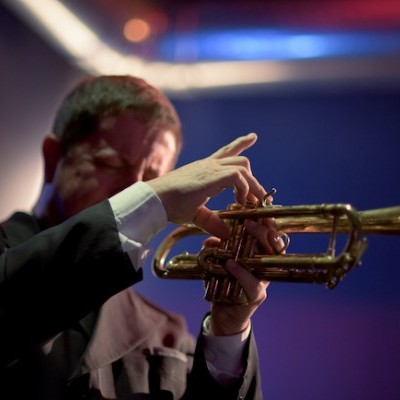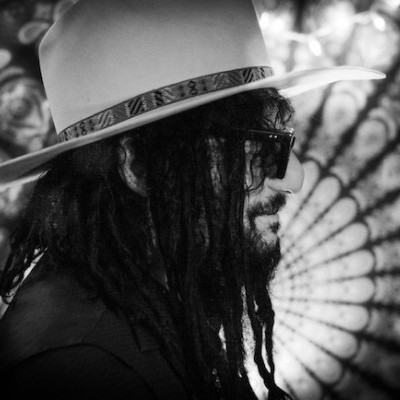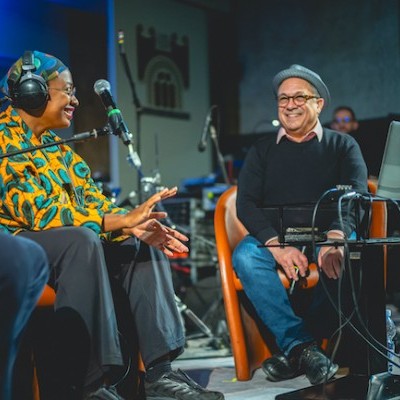Jul 9, 2024 11:35 AM
Trumpeter, Educator Jim Rotondi Dies at 61
Jim Rotondi, a renowned hard-bop trumpeter, composer and educator, died suddenly on July 7 at a hospital in France. He…

Joe Fiedler’s new album is Open Sesame.
(Photo: Peter Gannushkin)Jazz musicians have tapped all kinds of sources for material—folklore, hymns, Broadway—but Joe Fiedler has found his inspiration in a rather unexpected place: Sesame Street.
For Fiedler, the choice was obvious—and perhaps inevitable. For the past nine years, the 54-year-old trombonist has served as the musical arranger for the children’s TV show. On his playful new record, Open Sesame, Fiedler interprets some of the program’s most famous tunes, including “Sing,” “Rubber Duckie” and the show’s theme song, as well as lesser-known but equally enjoyable numbers, like “Doin’ The Pigeon.”
“I really wanted to do something that was not so serious,” said Fiedler, wearing polka-dotted socks, in an interview at a Brooklyn recording studio, where he was wrapping up the final session for the 49th season of Sesame Street.
His intentions, though, were far from juvenile, and the album reflects Fiedler’s diverse aesthetic, as he blends elements of funk, rock, free-jazz and New Orleans polyphony into a potent mix that gives depth and texture to the lighthearted compositions, most of which were written by Joe Raposo (1937–’89), the show’s first music director.
A Pittsburgh native, Fiedler moved to New York in the early ’90s and insinuated himself into the downtown scene, while actively gigging in Latin music bands, because, as he joked, “There is no such thing as making your living as a jazz trombonist.”
In 2008, Fiedler was playing in Lin-Manuel Miranda’s Broadway musical In the Heights when he met Bill Sherman, now the music director for Sesame Street. Sherman was impressed with Fiedler’s abilities, so he brought him on to write, arrange and orchestrate cues and incidental music for the children’s show.
It was a good match for Fiedler, whose favorite characters are Grover and Cookie Monster, because they both make him chuckle. Like the show, Fiedler—known for his extensive range and impressive command of multiphonics—has managed to retain a mainstream audience while striving for weirdness, a trait that comes through gloriously in his expressive all-brass quartet, Big Sackbut. “I like being more the ‘out’ guy in the in world,” said Fiedler, who grew up watching the show.
At the beginning of his run, Fiedler set about establishing a signature sound that would distinguish his tenure at Sesame Street, which is now broadcast on HBO. He opted for the vibraphone instead of the glockenspiel, for example, in an effort to give his young audience a slightly more sophisticated sonic experience. “Vibes really sweeten the sound without sounding childish,” he explained.
“Because he’s fluid in so many styles, he’s got a lot of different bags to draw from,” said bassist Sean Conly, who plays on Open Sesame along with Jeff Lederer on saxophone, Steven Bernstein on trumpet and Michael Sarin on drums. “It’s insane what the guy is capable of.”
On a February evening at Dizzy’s Club Coca-Cola in Manhattan, Fiedler demonstrated his trombone wizardry in a concert that featured guest appearances from both Wynton Marsalis and the beloved puppet Elmo. Though there were some children in the audience, Fiedler said that at most of the shows he’s done in this vein, those who turn out often tend to be adults who grew up watching Sesame Street on public television in the 1970s.
Fiedler has taken a number of liberties with the material, but said that audience members still appreciate his work because they recognize the tunes. As long as the melodies are at least faintly discernible, he said, he can do a fair bit of experimentation on the margins.
With this in mind, it’s amusing that, after nearly a decade composing music for kids, Fiedler has produced a tribute to Sesame Street that is decidedly not intended for children’s ears.
“I’m not sure that kids would get it,” he said. DB

Jim Rotondi was acclaimed for his wide, round trumpet tone, remarkable virtuosity and assured swing.
Jul 9, 2024 11:35 AM
Jim Rotondi, a renowned hard-bop trumpeter, composer and educator, died suddenly on July 7 at a hospital in France. He…

Charles Lloyd, seen here at the 2024 New Orleans Jazz & Heritage Festival, makes DownBeat Poll history!
Jul 11, 2024 12:23 PM
The incomparable Charles Lloyd swept the 72nd Annual DownBeat Critics Poll, becoming the first artist ever to earn…

“Being president of Blue Note has been one of the coolest things that ever happened to me,” Was said. “It’s a gas to serve as one of the caretakers of that legacy.”
Jun 4, 2024 12:21 PM
Sitting with Don Was is a comfortable and unhurried exercise. He may seem slightly reserved at first, but ideas and…

“She reminds me of my childhood and makes we want to cry,” Cécile McLorin Salvant, pictured here with writer Ashley Kahn, said of Dianne Reeves.
Jun 11, 2024 12:31 PM
Italy’s Umbria Jazz Winter is one of those rare annual festivals that not only coincides with a major holiday —…

Maria Schneider said of Decades, her new compilation release: “I just wanted to create something, put it in a beautiful box and say, ‘Look at what we did.‘”
Jun 18, 2024 12:00 PM
Maria Schneider opened the sleek black box and placed it on a coffee table in her Manhattan apartment. Inside lay the…